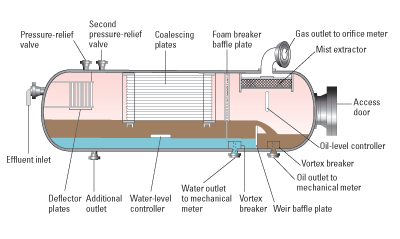1. n. [Production Facilities]
A cylindrical or spherical vessel used to separate oil, gas and water from the total fluid stream produced by a well. Separators can be either horizontal or vertical. Separators can be classified into two-phase and three-phase separators (commonly called free-water knockout). The two-phase type deals only with oil and gas, while the three-phase type handles oil, water and gas. Additionally, separators can be categorized according to their operating pressure. Low-pressure units handle pressures of 10 to 180 psi [69 to 1241 kPa]. Medium-pressure separators operate from 230 to 700 psi [1586 to 4826 kPa]. High-pressure units handle pressures of 975 to 1500 psi [6722 to 10,342 kPa]. Gravity segregation is the main force that accomplishes the separation, which means the heaviest fluid settles to the bottom and the lightest fluid rises to the top. Additionally, inside the vessel, the degree of separation between gas and liquid will depend on the separator operating pressure, the residence time of the fluid mixture and the type of flow of the fluid. Turbulent flow allows more bubbles to escape than laminar flow.
See related terms: free-water knockout, horizontal separator, oil and gas separator, spherical separator, stage separation, three-phase separator, two-phase separator, vertical separator
